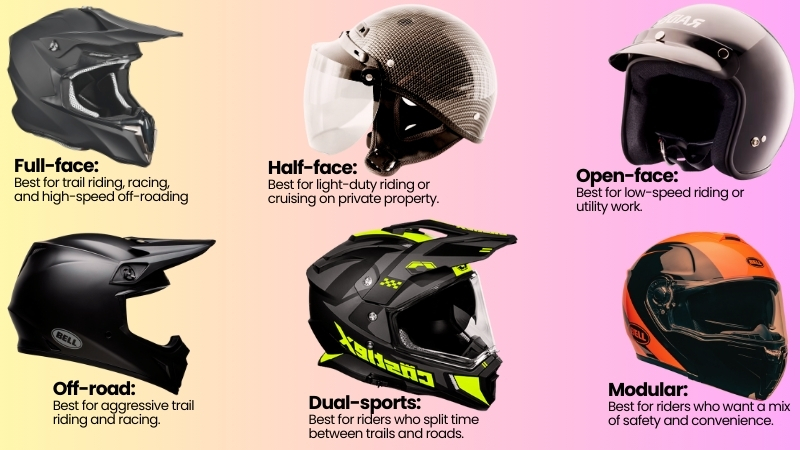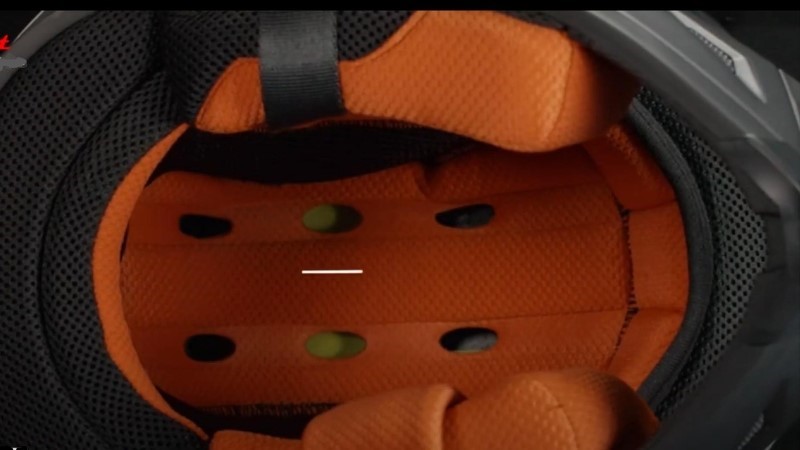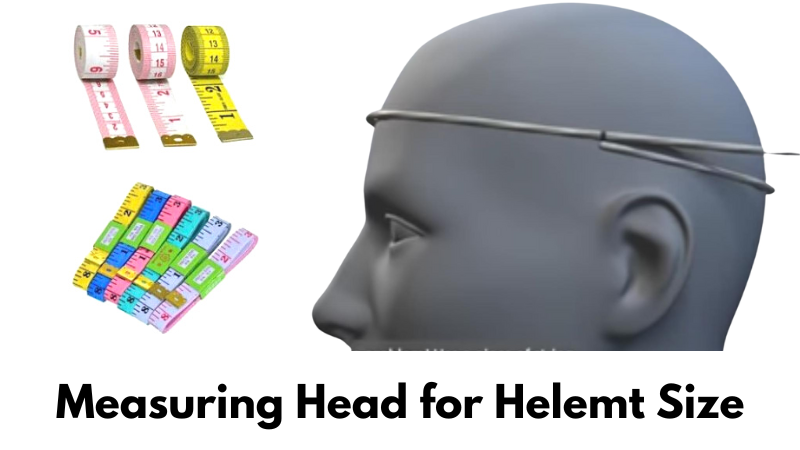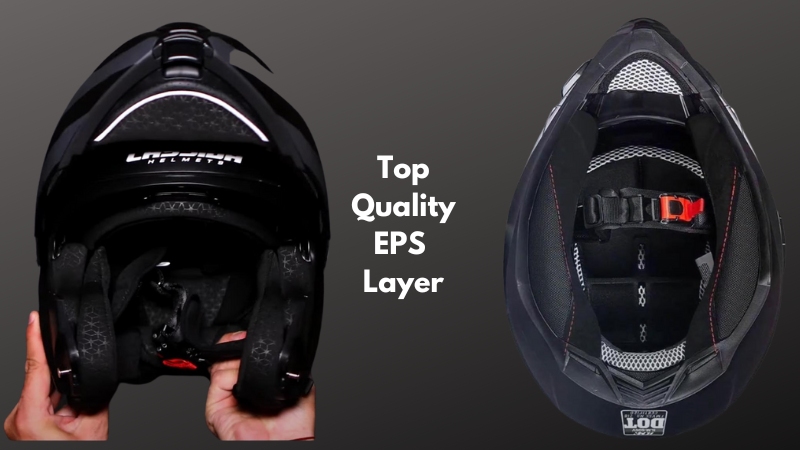Look—riding an ATV is all about freedom, fun, and maybe a little mud in your teeth. But none of that matters if you’re not protected when things go sideways. A good helmet isn’t just gear—it’s your first line of defense, your peace of mind, and quite literally your head’s best friend.
The truth is, not all helmets are built the same. Some are made for high-speed trails, others for casual farm work. Some give you full-face coverage, while others keep it light and breezy. But picking the right one? That’s where most folks get it wrong.
So let’s break it down—real simple. I’ll show you what to look for, what to avoid, and how to find the helmet that fits your riding style and keeps your head in one piece.
Jump To Contents
- Why You Need a Helmet While Riding an ATV
- Head Injuries Are the #1 Cause of Death in ATV Crashes
- You Can’t Control the Terrain—or Other Riders
- Protection From More Than Just Crashes
- It Keeps You Warm (or Cool)
- Rain, Dust, and Mud Won’t Ruin Your Ride
- It’s Often Required by Law or Insurance
- Sets a Good Example—Especially for Kids
- Makes You Stand Out
- Start by Determining the Right Type for You
- How to Choose the Best ATV Helmet for You?
- How to End up with the Right & Best ATV Helmet?
Why You Need a Helmet While Riding an ATV
Because your head isn’t built like an ATV.
ATVs are fast, powerful, and often driven on rough terrain—think rocks, tree roots, uneven trails, and surprise obstacles you didn’t see coming. Even if you’re the best rider on the planet, accidents happen. And when they do, it’s usually your head that takes the hit.
Here’s why a helmet is non-negotiable:
Head Injuries Are the #1 Cause of Death in ATV Crashes
A helmet can reduce the risk of severe brain injury by up to 85%. That’s not just some scary stat—it’s the difference between a bruised ego and a life-altering trauma.
You Can’t Control the Terrain—or Other Riders
Loose gravel, wet grass, hidden dips—ATVs aren’t always predictable, especially at higher speeds. A helmet gives you a critical layer of protection when nature decides to throw a curveball.
Protection From More Than Just Crashes
Tree branches, flying debris, bugs, or even your own front tire kicking up rocks—without a helmet, your face is a target. A visor or full-face helmet shields your eyes, nose, and mouth.
It Keeps You Warm (or Cool)
Helmets aren’t just for safety—they help regulate temperature, too. In cold weather, they lock in warmth. In summer, ventilated helmets can keep your head cool while deflecting sun and sweat.
Rain, Dust, and Mud Won’t Ruin Your Ride
Ever caught a face full of mud at 30 mph? Not fun. Helmets block out the mess so you can focus on the ride—not wiping your eyes or digging grit out of your teeth.
It’s Often Required by Law or Insurance
In many states and countries, riding without a helmet can land you a hefty fine. Some ATV parks won’t even let you in without one. And if you ever need to file an insurance claim after a wreck? No helmet = denied coverage in a lot of cases.
Sets a Good Example—Especially for Kids
If you ride with your kids, friends, or a group, wearing your helmet every time shows responsibility and encourages others to do the same. That kind of leadership literally saves lives.
Makes You Stand Out
Helmets aren’t just about safety—they’re also a chance to show off your personality. Preferred colors and designs make you more visible on the trail and let you look good doing it. Whether you’re into matte black or neon flames, your helmet can make a statement.
Start by Determining the Right Type for You
When the stake is to choose the right helmet, you must start by analyzing various types of helmets used for ATV riding. These are the most popular off-road helmets to choose from; anyone can translate well to ATV riding in particular.

Full- Face Helmets
Full-face helmets are the safest helmets available in the marketplace. It covers your entire face and head, ensuring safety from injuries and fatal accidents. In addition, these helmets are the heaviest and allow the least airflow around your head.
Best for: Trail riding, racing, and high-speed off-roading.
- Covers the entire head, including the chin and face.
- Offers the highest level of protection.
- Often includes a visor and good ventilation.
- Great for protection against debris, bugs, and branches.
Pros: Maximum safety, good for all-weather riding.
Cons: Can get hot and heavy over time.
Open Face Helmets
Unlike full-face helmets, they are lighter and less protective. And you can use this helmet with proper eye protection to ensure your safety while riding an ATV but it is not a popular recommendation for max safety.
Best for: Low-speed riding or utility work.
- Covers the top, back, and sides of your head but leaves your face exposed.
- Typically paired with goggles for eye protection.
- More lightweight and breathable.
Pros: Great visibility and ventilation.
Cons: No chin protection.
Off-Road/Motorcross Helmet
The off-road helmet is the most popular type available in the marketplace. It covers your head entirely while your face remains exposed (except the mouth area and chin). But you can use additional eye protection to guard your eyes while riding.
Best for: Aggressive trail riding and racing.
- Features a sun visor and elongated chin bar for more airflow.
- Designed for use with separate goggles.
- Often used by motocross and dirt bike riders.
Pros: Excellent airflow, designed for rough terrains.
Cons: Not ideal for cold or wet weather.
Modular Helmet (Flip-Up)
Modular helmets are the most versatile helmets. It covers three quarters of the entire face. The helmet also works like an open-face helmet.
Best for: Riders who want a mix of safety and convenience.
- Similar to a full-face helmet but with a flip-up chin bar.
- Allows you to talk, eat, or take a breather without removing the helmet.
- Good for casual or utility ATV use.
Pros: Versatile and convenient.
Cons: Slightly less secure than full-face helmets.
Half Helmet
The name is expressive of its protection, covering your skull only partially, leaving your chin and face exposed and so somewhat unprotected. But they are better ATV headgear for longer cruising and riding. If you opt for or have to use this, goggles are a must to protect your eyes.
Best for: Light-duty riding or cruising on private property.
- Only covers the top of your head and part of the sides.
- Leaves your face and jaw completely exposed.
- Very minimal design—similar to what you’d see in cruiser motorcycle helmets.
Pros: Extremely lightweight, great airflow.
Cons: Least protective, not suitable for rough terrain or high-speed riding.
Dual-sports Helmet
This is the most versatile of all the types discussed here and is a go-between of the off-road and full-face helmets. They are a good fit for trails and roads, thus earning the tag dual-sports. Featured with a push-up face visor, you can ride without goggles.
Best for: Riders who split time between trails and roads.
- Combines features of off-road and full-face helmets.
- Has a visor and face shield, but also allows for goggle use.
- Good for all-around versatility.
Pros: Good mix of comfort, protection, and airflow.
Cons: Not as specialized as full-face or motocross options.
Recommended Read: 7 Top-rated Bluetooth ATV Helmets for 2025 & Beyond
How to Choose the Best ATV Helmet for You?
After selecting which type of ATV helmet you need and want to buy, you must find the best one of this type. Here are critical things you should give a damn about while you are after the best.
Safety Rating – Certifications

Check your helmet’s safety standard and ensure it has a good safety rating. There are two main certifications to measure safety standards – DOT and Snell in the USA. For an ATV rider in Europe, go by CE(French) and ECE (Entire Europe). These are the industry standard ratings assuring the helmet has passed all the extreme safety standards. A helmet boasted of these safety ratings – will have top quality Styrofoam-like cushion to absorb the force of impact – sudden fall or hit. However, the ATV helmets featured with a thicker EPS lining are the best for impact resistance.
Helmet Comfort

Next to safety comes comfort. If the helmet is uncomfortable, you may end up having a terrible riding experience and cutting your ride short.
Ensure your helmets form enough seals around the ear but do not touch your ear to enjoy max riding comfort. The Padding should be tight to your face, so it adjusts appropriately with your face. But the fabric should be high-end so that it tends to perspire and build fungus the least.
Size & Fit

Getting the correct fit is the prime concern for the rider. So, make sure your helmet fits snugly but is neither too tight nor loose enough to shove a finger between your head and the helmet easily. Just keep a little space to ensure comfort. Every company has different size standards, so try the demo models yourself before buying.
Measure the circumference of the widest part of your head to get your ideal helmet size. In fine, the helmet should be a perfect fit so that it does not move around while riding. The perfect fit helmet better be a bit uncomfortably snug when new and will become comfortable within days after the breaking-in period.
Dig Deeper: Why and How to Wear Goggles with ATV Helmet – The Ultimate Guide
Peak vs. Visor
Whether you want a helmet with a peak or visor or one with both of them is a crucial consideration to make when it comes to choosing the right helmet for your ATV riding adventures.
A peak is common with ATV helmets that provide shade from the sun while also protecting your face from roosts and debris kicked up by other riders. On the other hand, a visor is usually found on off-road helmets, especially on motocross helmets, and offers protection against wind, rain, and bugs.
So, which one should you choose for your ATV adventure? It ultimately depends on your personal preferences and style of riding. If you’re more of an aggressive rider who likes to tackle rough terrain, then a peak might be more suitable as it will protect your face from flying debris. However, if you prefer long rides on open trails or roads, then a visor may be more practical as it will shield your face from wind and weather elements.
It’s worth noting that some ATV helmets come with both a peak and visor option so that riders can switch between them depending on their needs.
Ventilation

Unlike motorcycle helmets, ventilation matters much for ATV helmets as riding ATV is done mostly in summer and in hot, dusty areas. Latest ATV helmets are manufactured keeping the high airflow in mind because well ventilation is a must to deal with sweat – the by-product of longer ATV rides. That’s why most off-roaders prefer open-face alternatives to others. Ventilation may not be a crucial safety feature, but it is essential for comfort. Aerodynamics comes side by side with ventilation, but ATV riding is far slower than motorcycle riding; the aerodynamics of the ATV helmet is not that important. However, it is a bonus if it is there.
Shell Material
Safety is offered in exchange for money when considering shell material for ATV helmets. The safer option you choose, the more money you have to pay. Talking of safety, the shell is the most important part of a helmet. You have four alternatives to choose from:
Polycarbon: The cheapest and the least durable option.
Fiberglass: Costlier and sturdier than polycarbon but will not survive cracks.
Kevlar Fiberglass Hybrid: A considerably sturdier helmet material to withstand high impact and a fairly expensive one.
Carbon Kevlar Hybrid: The most expensive and exclusive helmet material and considered nearly unbreakable. But save you money in the long run as you don’t have to replace it for at least 5 years of off-roading.
Yes, you can choose the budget and cheaper alternative featured with the required inner lining thickness. But you must be ready to replace it sooner.
Basic Features
As for basic features, your target ATV helmet’s quality test will be determined by the chin strap, weight, and inner lining. Although they are not the only features you should look for, they are crucial for safety and comfort. Too light a helmet should thoroughly check for material quality as low-quality shell material may crack easily.
Likewise, the material and fit of the chin strap are also crucial as it prevents the helmet falling from your head. This is why all the top-notch ATV helmets come with an adjustable and beefy chin guard – the best location for mounting your Gopro. As for the inner lining, it should be 1 inch thick to give premium protection to your skull by absorbing energetic impact.
Advanced/Sophisticated Features
To talk of advanced features, the removable inner lining comes first for washing convenience to keep the helmet clean and fresh. Eye-catchy graphics and stand-out color in your helmet make you more conspicuous and easily recognizable. To add inline, snap out cheek pad will ensure a custom fit and extra cushioning.

Some helmet manufacturers design theirs with a quick-change face shield to enable visor change after your choice. And the helmets without any visors better have a wide aperture to accommodate large goggles and clear all-around vision.
For increased absorption and reduced concussion, the high-end EPS layer is peerless as it features a variable density of layered materials.
If and when smashing ground at face first fall, a helmet featured with layered liner is the best bet to reduce the chance of whiplash.
Dig Deeper: Best Budget ATV Helmets
Cost
Helmets are worth every penny as they are life savers, but that does not mean you have to buy the most expensive one. Look for extra features like a no-fog face shield, unique graphics, anti-bacterial fabric, etc., at a little more cost, but it’s worth every penny. Don’t go for cheap and low-quality helmets because doing so amounts to taking reduced comfort and risks your safety.
As a reminder, cheaper low-quality products can compromise quality, comfort, and safety, but the high-end price is not a guarantee to them either.
Frequently Asked Questions – FAQs
When Should You replace your ATV helmet?
The best practice is replacing your helmet every five years as quality deteriorates with time. But regular maintenance, making ATV helmets cleaning a ritual, will result in extending the life of this safety gear.
Going back to a replacement, if your helmet has already suffered an impact, immediately replace it with a new one designed to offer comfort, safety, and more. Don’t use a helmet with cracks and dents, as helmets with those issues entail compromised safety. You can also buy a new helmet if you use an old-fashioned one.
How to know if an ATV helmet is fitted correctly?
If the Padding is a little tight and adequately adjusted to your face, then it’s of your size. Another check for a perfect fit; if your head moves with the helmet when moving vigorously with your hands (once the strap is snug), it’s an ideal fit for you.
What should you consider most at the time of selection of ATV helmets?
You can go for a helmet that is either DOT or Snell-approved. It should fit you snugly to stay in place while riding without being uncomfortable. You can also look for extra features such as a no-fog face shield, adjustable straps, beefy chin guard, unique graphics, anti-bacterial fabrics, etc.
How do I know my helmet is damaged?
You can look for cracks or any evidence of crushing in bright light. You can also send your helmet to manufacturers to do the inspection. If there is minor damage, you don’t necessarily need to change your old helmet, but if there are significant crushing, dents, and cracks, you have to buy a new one.
How to End up with the Right & Best ATV Helmet?
Look, you can replace tires. You can fix bent handlebars. But you only get one brain—and once it’s damaged, there’s no reboot button.
Wearing a helmet isn’t just about safety. It’s about showing up smart, riding with confidence, and setting the standard for everyone around you. Whether you’re tearing through trails or just cruising the back 40, your helmet is your most loyal riding partner.
So here’s the deal:
Be bold. Be smart. Be the rider who shows up, gears up, and never rides without one.
Relevant Reads include: